Mallorca welcomed Atlético Madrid to the Iberostar Stadium for a clash between La Liga rivals Atlético Madrid. Atlético manager, Diego Simeone managed to lead his side to a 2-0 away victory against Vincente Moreno’s Mallorca side.
The result leaves Mallorca in 17th place, level on points with 18th place Espanyol in the relegation zone. Atlético Madrid, on the other hand, are up to second, just one point behind league leaders and city rivals Real Madrid after six games played.
This tactical analysis will investigate how Atlético were able to beat the team from Mallorca. The analysis will include information on tactics, offensive, defensive and transitional components of play from each team as well as other key match events.
Line-Ups
Within the match, Mallorca predominantly utilised a 4-4-1-1 formation, while Atlético Madrid were found to use their typical 4-4-2.
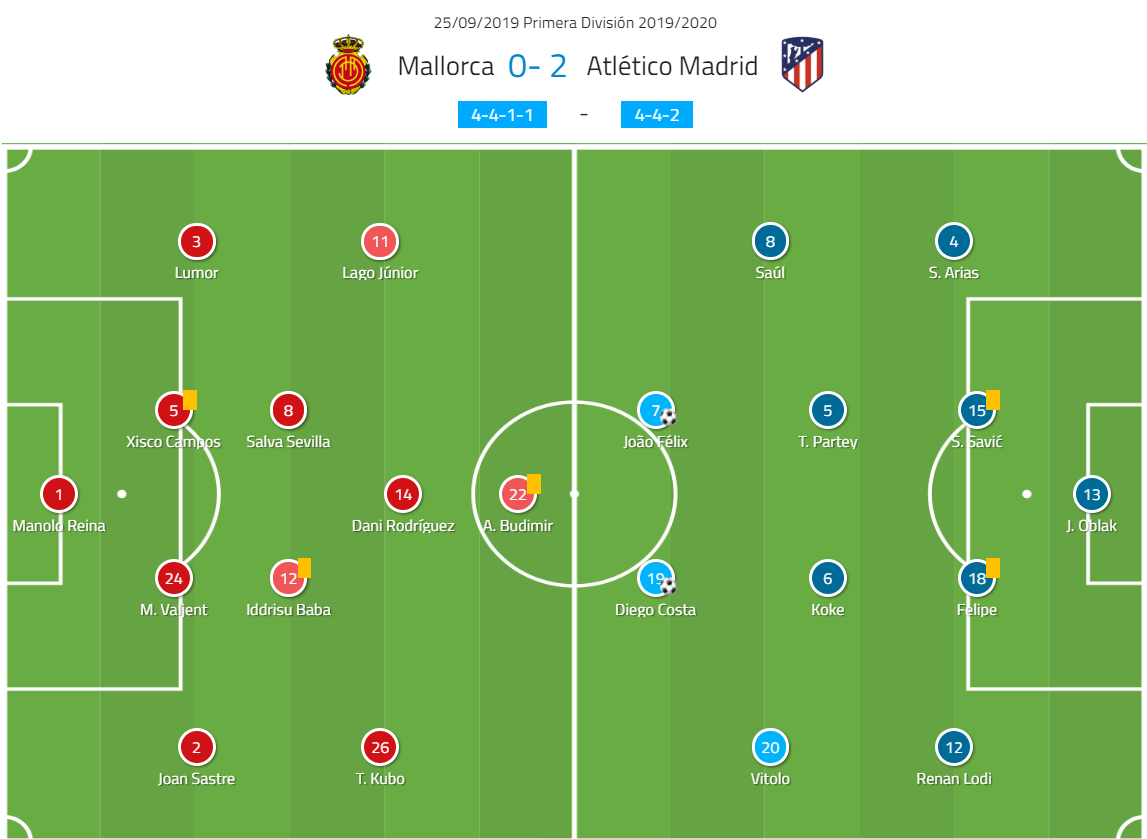
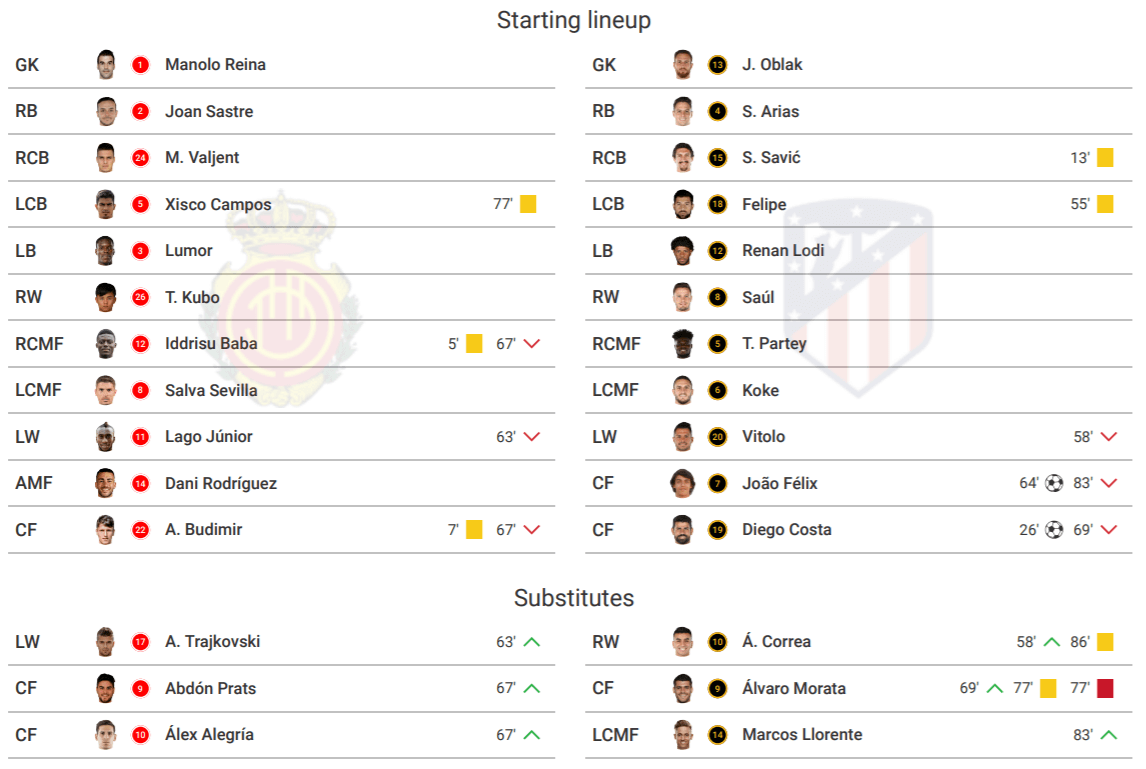
Average formations
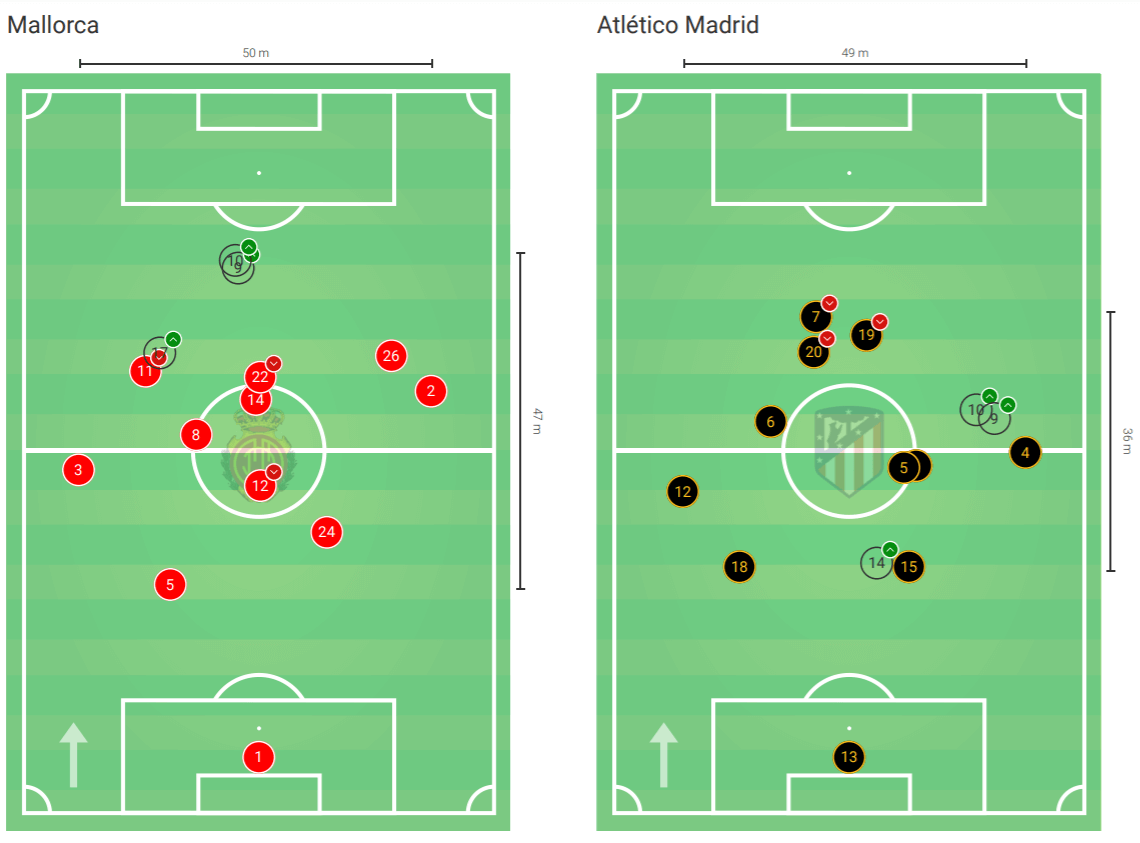
The formations of both teams have been outlined, however, within the match, their average formation portrays a different picture. Mallorca’s formation was manipulated with the lone striker dropping back to receive the ball, whilst the wide players pushed up either side of the striker and the number ‘10’ player to offer width and attacking movement. Interestingly, the right-back for Mallorca pushed up frequently, with his average position close to that of the right-winger.
Atlético operated using a narrower formation in offensive positions, set up with the left-winger, Vitolo, moving inside to link-up with the two strikers, Diego Costa and João Félix, while the right-winger, Saúl Ñíguez, tucked into a more central midfield position. The right-back, Santiago Arias, offered width on the flank.
This information will be useful when discussing tactical ploys in and out of possession and in transitional phases.
Match Stats
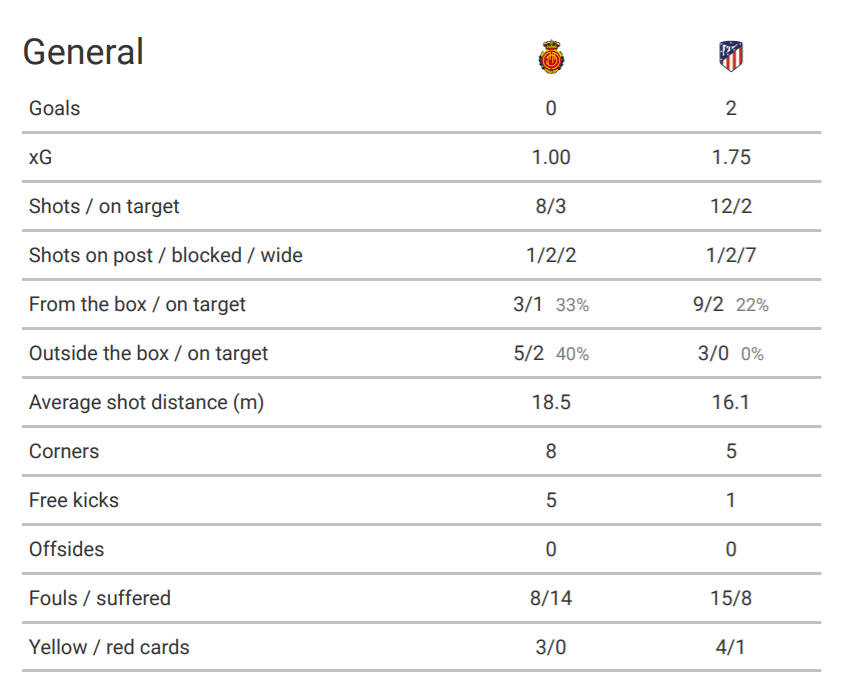
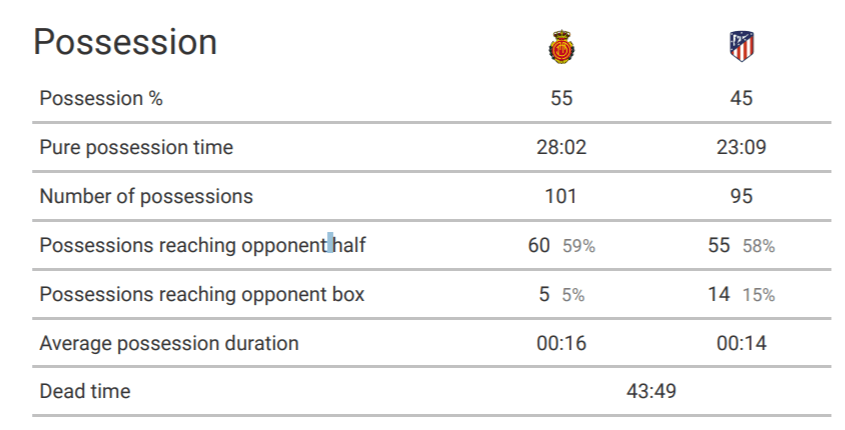
By taking a look at the match stats we can see that while Atlético managed to win the game 2-0, they did not dominate the ball as Mallorca had 55% of possession. However, football is a game where possession needs to be meaningful. If we take a look at the xG, Atlético were superior, although not enough to suggest that they should’ve won the game as comfortably as they did. Mallorca were expected to score one goal and so under-performed, Atlético over-performed slightly with two goals from an xG of 1.75. This suggests that Atlético Madrid were able to progress the ball into better shooting positions more often than Mallorca, from there, a combination of impressive finishing and/or poor goalkeeping enabled Atlético to score two goals. On the other hand, a combination of poor Mallorca finishing and/or excellent Atlético goalkeeping is possible when analysing Mallorca’s lack of goals.
The match statistics reinforce the notion of Atlético being able to get into more dangerous positions, 75% of all their shots were inside the box, with all two shots on target coming from those nine in the box. This suggests that Atlético were able to penetrate Mallorca on numerous occasions to achieve a shooting opportunity within the penalty area.
Just 37.5% of Mallorca’s shots were inside the Atlético penalty area, with only one of their three shots on target coming from these positions, this suggests that Atlético were able to limit Mallorca to efforts from distance. Therefore, while Mallorca should have expected to score at least one goal based on xG, it is likely that a lot of their shots were of low xG value, due to 62.5% of their shots coming from outside the box.
Again, this information will be useful when investigating the tactical aspects of the match further.
Mallorca in possession
For the majority of the match, Mallorca were nullified by Atlético Madrid when in possession. It was clear that Mallorca wanted to get their offensive players on the ball in order to link up and try to split the Atlético defence.
Atlético nullified this well with a very narrow formation. Both strikers dropped behind the ball to block passing lanes to Mallorca central midfielders, behind them there were the two central midfield players, with wide-players inverted to offer more bodies in the middle of the park. The back four was quite ordinary in their set up, but, their distances between the midfielders and their knowledge on when to press the opposition in wide areas was impressive.
Such defensive organisation led to a lack of space for Mallorca to play in. Because of the block of Atlético players in central areas, Mallorca has to try and play around their opponents. However, as they played wide to a winger or advanced full-back, the wide inverted players for Atlético would rush out to block any advancements, as would the Atlético full-back if he was sufficiently supported with cover behind him.
This led to issues for attacking players like Takefusa Kubo, a left-footed player playing on the right of the Mallorca midfield. He wanted to drift in, pick up the ball and play, but the lack of space and the numbers in central areas for Atlético made this impossible. Given Kubo’s footedness, he could not stay wide and go around the outside of the defence. The full-back could have overlapped Kubo, but the defensive contribution of the registered wide-men for Atlético made this difficult. This also led to the number ‘10’ and striker becoming isolated in central attacking positions, they could pick up pockets of space behind the Atlético midfield and in front of their defence, but they found it difficult to receive the ball with time and space to play, an Atlético player was on them straight away in an attempt to win the ball back.
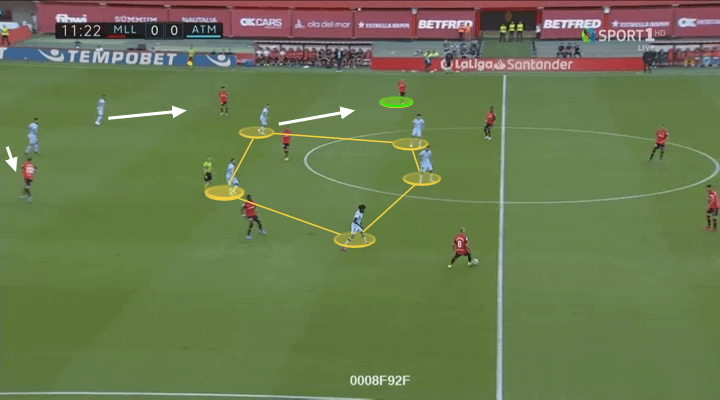
Atlético Madrid in transition
Atlético Madrid were happy to maintain their shape, allowing the Mallorca defensive line approach the halfway line and attempt to break them down. Once Mallorca had played wide, as mentioned, the wide player for Atlético who had been sitting narrow, was onto the opposition player to apply pressure, the Atlético full-backs and centre-backs were also ready to pounce should a player or pass reach their area of engagement.
Once Atlético won the ball back, they sprung a counter-attack. This was aided by their narrow formation and teammates close by who had dropped to maintain shape, including the strikers. Atlético consistently had passing networks to choose from and link-up with to progress the ball. The technically gifted, Félix frequently dropped back from his registered strikers’ position to increase the overload Atlético had in midfield and link with his teammates, operating with flair and skill to further disrupt the Mallorca defence.
With space to play on the counter, Atlético enjoyed their transitions within the game and while no goals were scored, chances were created.
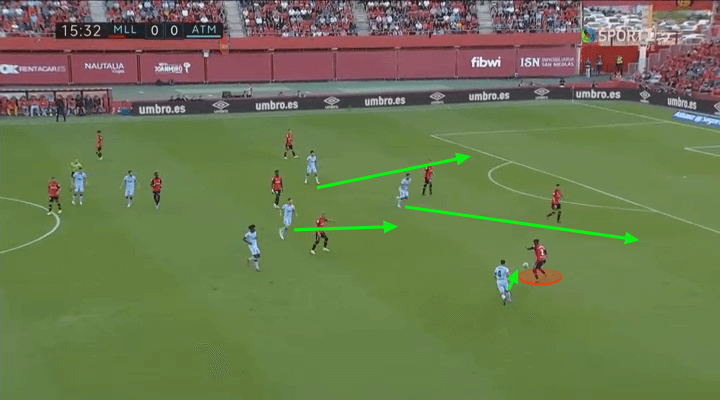
Atlético Madrid in possession
In possession, Atlético’s quality was displayed. While the team did not score from a normal sequence of possession, Atlético were able to progress through the thirds, often utilising their narrow formation and inverted wingers to overload central areas while their full-backs advanced in order to offer a wide option and maintain the attention of the opposing winger and full back. Félix was the key to Atlético’s success, the player dropped deep to receive the ball and get Atléti playing, often dropping deeper than his own central midfielders, Mallorca did not know who should pick up the roaming forward. From there, Atlético were able to build up the pitch via link-up play and occupy opposition defenders via false runs. Félix, and the other attacking players, including the inverted wingers, then had space to receive the ball and link just outside the box due to the confusion of Mallorca in terms of marking players with effective and fluid movement.
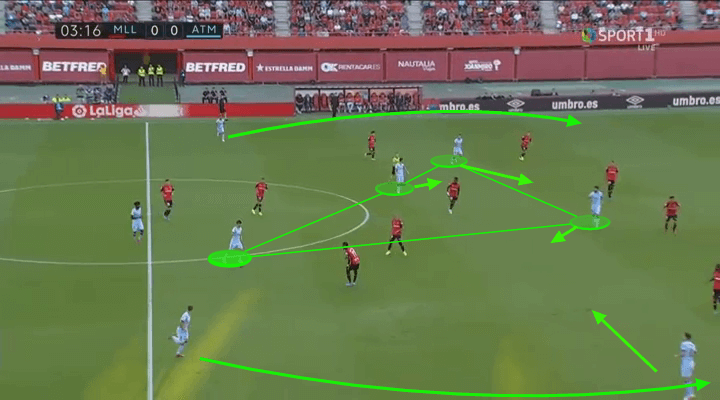
Mallorca in transition
In transition, Mallorca were very similar to Atlético. The Mallorca wingers moved inside to help with quick attacks and combination play. Mallorca also played with a number ’10, Daniel Rodríguez, so they had the advantage of a natural playmaker occupying the half-spaces between Atlético’s midfield and defence when Mallorca won the ball back and had the chance to break.
It was the transition phase in which Mallorca created their best chance of the match. Young talent, Kubo picked the ball up just inside his own half and set off a run which involved a five vs four overload scenario with Atlético defenders running back towards their own goal. Kubo linked up with his teammates but continued running towards goal. Multiple pass and move one-twos gave him a shooting opportunity within the Atlético box. Unfortunately, his shot was tipped onto the inside of the post by Jan Oblak, from there it is difficult to understand how Atléti managed to keep the ball out of the net due to pressure from Mallorca players, but the team from Madrid maintained their clean sheet.
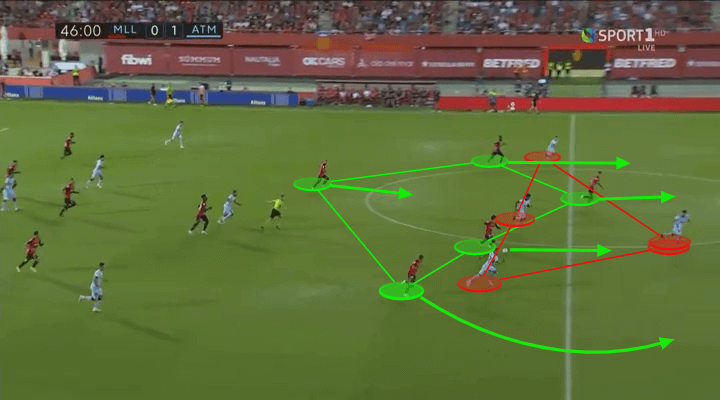
Set pieces
Despite their open play exploits, Atlético Madrid were able to score both goals from the second phase of set pieces. However, it was a combination of their offensive play when in position and in transition which enabled the team to earn set-pieces in dangerous areas.
Their set-piece set up was nothing out of the ordinary in terms of offensive corners and free kicks. However, Atlético did manipulate their set-piece routines in order to surprise Mallorca and gain space and time to attack the ball.
For Atlético’s second phase corner goal, a near-post delivery failed to beat the first man and was cleared back out to Koke, his second delivery was better. While Mallorca were man-marking the Atlético players which the ball travelled to, the Atlético players gambled in an attempt to win the ball, centre-back. Stefan Savić jumped but just missed the ball and robust striker Diego Costa anticipated his teammate missing the ball and headed into the corner.
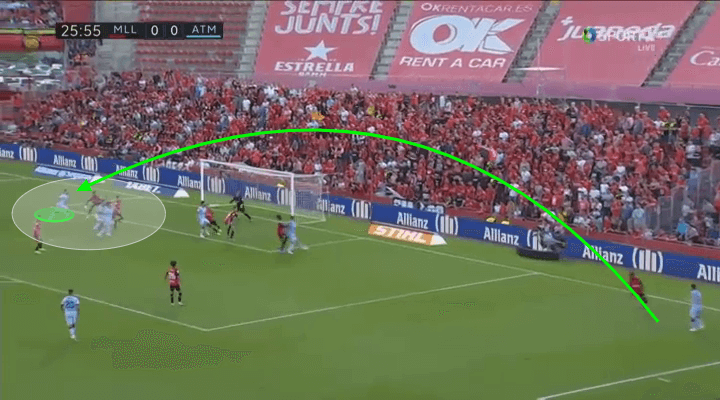
The success of Atlético’s second goal in the form of a second phase free-kick was the standard set up, manipulated by the use of a short pass. As the ball was passed, two Mallorca players broke out of the defensive line on the edge of the box and closed down the player. This allowed a through ball down the side of the Mallorca defence. The ball then came back out of the box on the flank but the disorganisation left Félix free when the cross was sent back in. There was some luck involved in the deflected finish, but the overall move caused confusion and offensive space for quality players to operate.
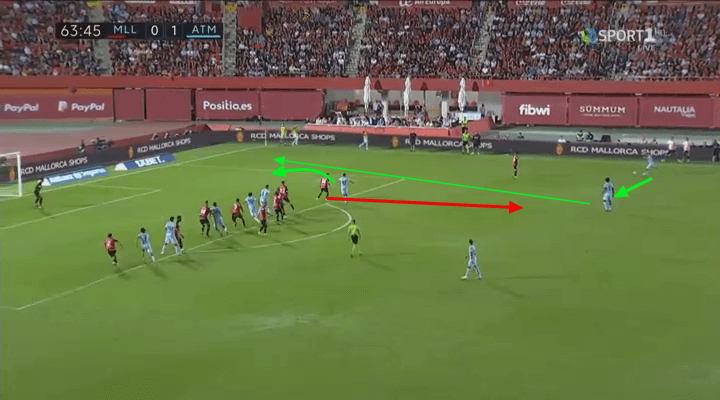
Mallorca had numerous set pieces from which they could have created chances and potentially score, however, the execution of such set pieces was poor. Mallorca had eight corners and two of those corners resulted in shots whereas Atlético had five corners and took a shot on two occasions, therefore enjoying a better corner to shot ratio. This stat was contributed to by the mixture of zonal and man-marking, and aggressive defensive headers from Atlético defenders.
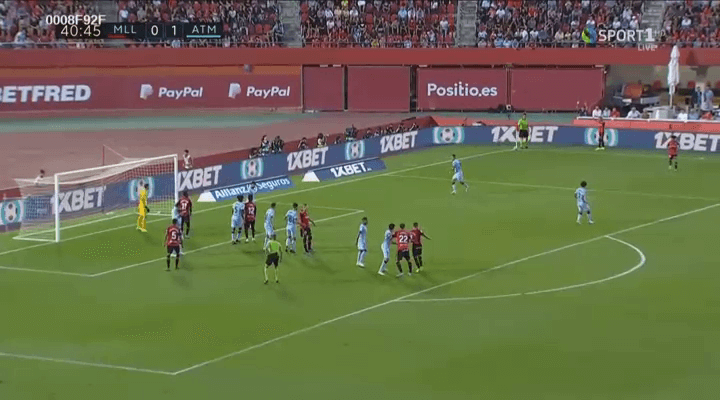
Mallorca did enjoy a direct free-kick on the edge of the box, although the resultant shot travelled straight at Oblak. In terms of wide free kicks, Mallorca often found themselves in similar positions to Atléti’s free-kick which they scored from. However, Mallorca opted to play the generic sequence of a cross between the goalkeeper and defence with a starting defensive and offensive line on the edge of the box. But, on multiple occasions, the cross from the Mallorca player failed to beat the first man.
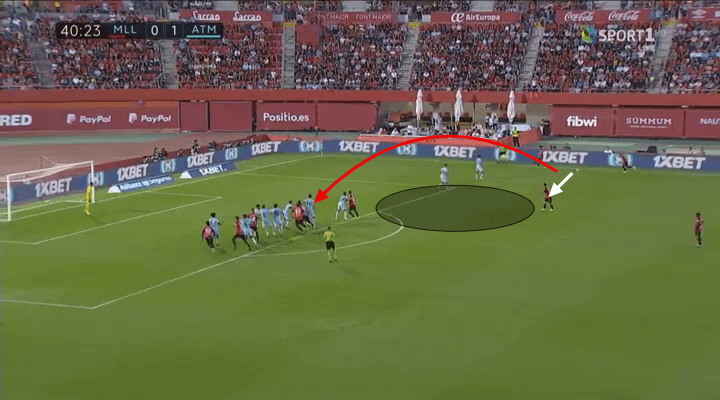
Other key events
In the 78th minute, Alvaro Morata, the Atlético Madrid striker, was sent off. Initially, he was enraged by a tackle. After receiving an initial yellow card for his aggressive nature and pushing his head against his opponent, he received a second yellow card for further dissent and unsportsmanlike conduct in the aftermath.
Luckily for Atlético, they were 2-0 up with around 15 minutes to go in the game when Alvaro Morata was sent off. In response, Atlético continued to remain compact, with every man behind the ball in a 5-3-1 and the most advanced player at the time, Félix, dropping in to block central passing lines.
The Atlético team retained their shape and allowed Mallorca to push on into their half. However, Atlético forced Mallorca wide, rather than offering space to play through the middle of the pitch. Once Mallorca had made progress down a flank, the closest defender in the five at the back pressed the player, with teammates behind marking any runs off the defence, the closing defender could confidently press and force the Mallorca player to play backwards, given the marked offensive options with the number of defensive options back.
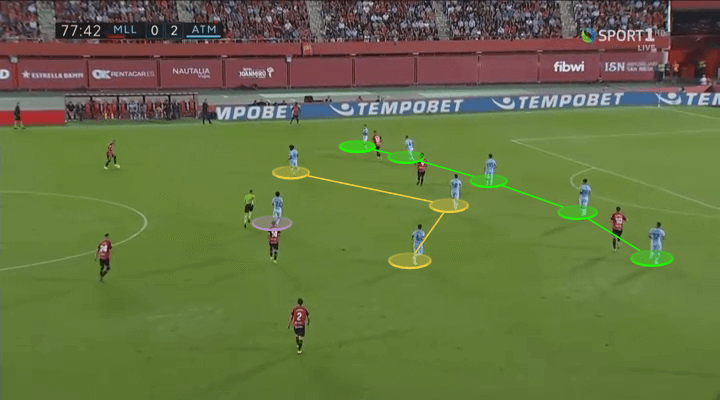
Conclusion
Overall, Simeone’s Atlético Madrid were the better team and deserved the three points against Moreno’s Mallorca. Their solid defensive structure provided a basis for success, while their swift transitions and effective movement of players in transition and possession caused problems for Mallorca. While the goals did not arrive from specific open play scenarios, Atlético’s positive play when on the ball enabled them to gain set-piece opportunities to score. Mallorca’s best chance came when young talent Kubo capitalised on a counter-attack, however, Mallorca lacked a clinical edge and quality when it mattered in open play and set-piece situations.
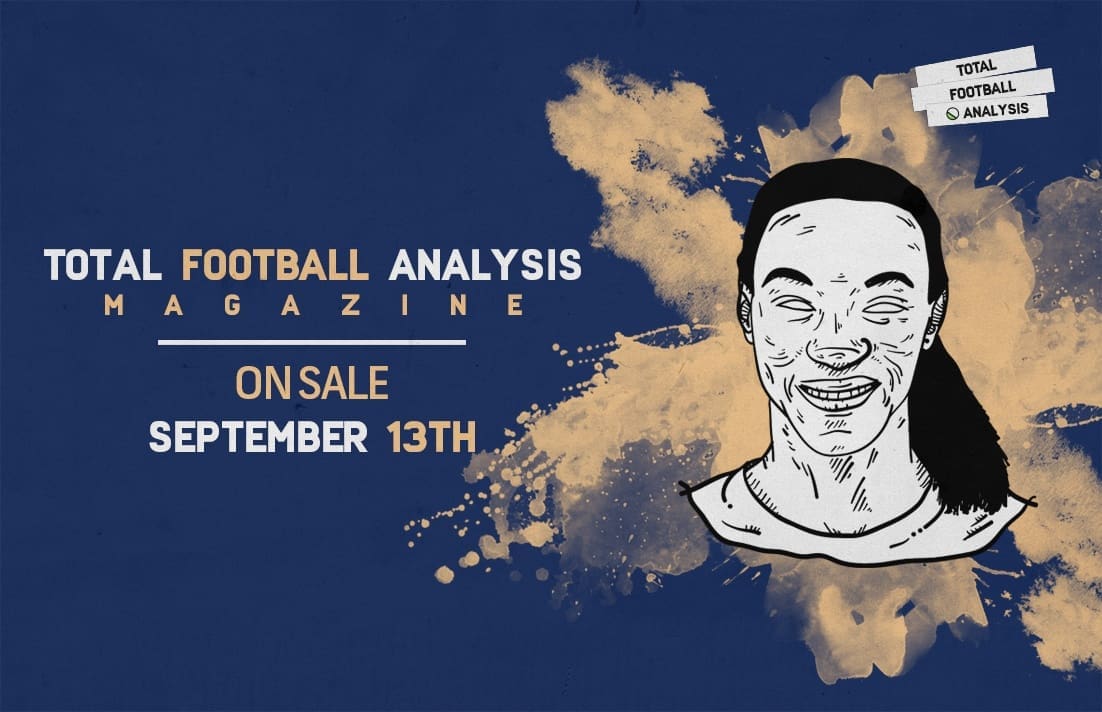
If you love tactical analysis, then you’ll love the digital magazines from totalfootballanalysis.com – a guaranteed 100+ pages of pure tactical analysis covering topics from the Premier League, Serie A, La Liga, Bundesliga and many, many more. Buy your copy of the August issue for just ₤4.99 here






Comments